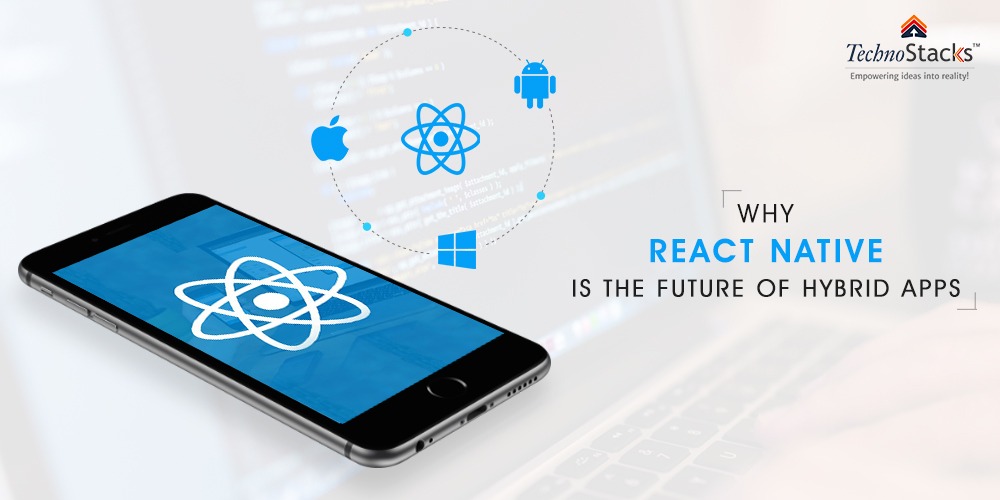What Is React Native – Why It Is the Future of Hybrid App Development
Introduction
It is precise to say that mobile phones have now become an integral part of our day to day life. With regards to Android and iOS enhancements, organizations often get confused with what should they opt or offer their clients. They are in a dilemma to move forward with a multipurpose application with unique User Interface (UI) and amazing User Experience (UX) or applications that are ideal with plentiful stages and are swifter to build in any scenario. With this situation, there comes the REACT Native Development in the depiction.
About React Native
React Native went through an astonishing fame and is sponsored by Facebook. It has an extensive and massive network bolster in the current time. React Native is based on ReactJS which has provided a mammoth rivalry to a long time of top preference, AngularJS. With the piece of information that there are a few likeness and dissimilarity among ReactJS and React Native, which are made with an orientation to underneath, React Native, is a system that builds a chain of command of UI components to erect the JavaScript code. It has a planning and structure of both iOS and Android stages to build a resourceful application with local look and feel.
With ReactJS being an open source JavaScript library supports in making great UIs. Be that as it may, equally React Native and ReactJS are created by Facebook with identical plan standards, to the side from structuring interfaces. As it uses a related code for making REACT Native iOS or the REACT Native Android apps, you merely require knowing the HTML, CSS and the JavaScript. How about we explore the implication of the REACT Native Framework here!
The React Native Framework is known as the Future of Hybrid Apps. Let’s see, What are the reasons behind it?
-
Supports both iOS and ANDROID
Formerly, Facebook just created React Native to be of assistance to iOS platform. Besides, with its partial help to the Android development frameworks and Android working platform. The library would now be able to render versatile UIs for the two stages.
So, Facebook decided to utilize React Native to manufacture its own Ads Manager application, making both an iOS and an Android version. A similar group of engineers worked on the two variants. Facebook additionally made React Native open-source, with the possibility that similarity with different stages like Windows or OS could be chipped away at by the improvement network, so it can remain tuned.
Best React Native App Development companies in The World -
Has Reusable Components which enables Hybrid Applications to Render Natively
Gone are the WebView components of other cross breed portable apps. This is feasible in light of the reality that React Native’s building squares are reusable “local segments” that get together purposely to local. Components you would utilize in iOS or Android have partners spot on in React, so you will get a consistent look and feel.
This part based structure furthermore empowers you to fabricate apps with a more quick, web-style way to deal with progression than compared to common half breed solutions, yet with no web by any chance. The application will have the swiftness, look, and expediency of a local portable system.
-
React Native is applied with UI Components To An Alive App’s Code – With No Rewriting At All
This is a massive reward for organizations that require extending an in progress application, however, would have a preference not to update it. Fuse React Native parts into the app’s code. Or on the other hand, if your existing half breed application was built with Cordova and Ionic, you can reuse that Cordova-based code efficiently with a module.
-
React Native is a Top Mobile JavaScript Framework amongst Developers and is continuously Maturing
If you know JavaScript, React Native is a swift pick-up, in effect enabling any of the front-end web developers to be an effective and on the spot mobile developer. No need to become skilled at iOS’s Swift or Java for Android – have knowledge of JavaScript, few of the native UI elements, know integration of platform APIs, and any other specific platform design patterns and you are able to get going. Also, comprised in React Native’s library are Flexbox CSS styling, debugging, inline styling, and support deploying to moreover the Google Play or App Store.
React is growing speedily and Facebook has initiated its advanced plans to carry on investing in its overall expansion.
-
React Native is meant for the Precise and Spot on User Interface (UI)
React Native is persistent exclusively on building a mobile UI. In comparison to JavaScript frameworks like Angular or React, React Native is majorly UI-focused, turning it more like a JavaScript library than an actual framework. The resulting UI is exceedingly responsive and feels fluid all credit to asynchronous JavaScript connections with the overall native environment. This means the application will have more rapid load times than a distinctive hybrid application and a smooth feel.
-
Native Application Development Is Much More Proficient and Competent
While native app development is more often than not connected with inadequacy, lesser developer productivity, and slow time of deployment, React Native is all about enhancing the overall pace and agility of web application development to the overall hybrid space with native outcomes.
Beneath React Native’s hood is Facebook’s trendy ReactJS UI library for different web applications. React Native enables all of ReactJS’s superior app performance, DOM abstraction, and easy programming methodologies to hybrid mobile app development.
-
Enables 3rd party Plugin Compatibility, Lesser Memory Usage and a Better Experience
The 3rd party plugins mean you won’t have to depend on a WebView for specific functions. For example, if you are adding Google Maps features and functionality to your application, React Native lets you connect the plugin with a native module, so you can connect the map up with the device’s specific functions including rotate, zoom, and the compass while using lesser memory and loading rapidly. If your application backs old operating systems, this can assist you to keep the application run very smoothly.
Moving Forward
React Native supports and enables you to make authentic as well as vitalizing applications with the backing of JavaScript. It is compatible with both Android and iOS stages. You just need to code once, and the React Native applications are available for both the iOS and Android stages which spare progression time.
Technostacks is one of the leading IT Company in India, has fruitfully carved its niche within a few years of its commencement. The company is occupied actively in offering comprehensive software solutions to cater to the demands of an assorted clientele across the globe.








